| Igneous
Rocks - Granite
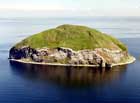 Granite
is one of the most easily recognisable and ubiquitous of igneous rocks
on Arran. It is a light coloured, coarse grained, intrusive igneous rock,
acidic in composition. It consists of quartz, alkali feldspar, mica and
variable amounts of amphibole. These can all be identified with the naked
eye. Granite
is one of the most easily recognisable and ubiquitous of igneous rocks
on Arran. It is a light coloured, coarse grained, intrusive igneous rock,
acidic in composition. It consists of quartz, alkali feldspar, mica and
variable amounts of amphibole. These can all be identified with the naked
eye.
Granites
can form from the partial melting of continental crust, by differentiation
of basaltic magma, by localised metasomatic effects on continental crust,
or by a combination of the above. On Arran, the granites are associated
with the British Tertiary Province (link to Tertiary?) , an episode of
intense magmatism linked to the break-up of the North American and Eurasian
continents.
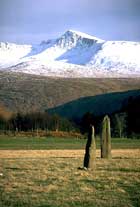 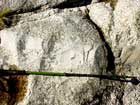 The
North Granite forms the prominent hills on Arran, including the highest
peak Goat Fell. The granite is in fact the roots of an ancient volcano,
exposed after 60Ma years of erosion. This large, circular pluton covers
an area of 146 square kilometres, and is made up of two separate periods
of intrusion (an earlier coarse grained outer member, and a younger finer
grained inner member). Aplite veining is pervasive. The veins of aplite,
a type of fine grained microgranite, represent the intrusion of the residual
magmatic liquids which were poor in volatiles. The
North Granite forms the prominent hills on Arran, including the highest
peak Goat Fell. The granite is in fact the roots of an ancient volcano,
exposed after 60Ma years of erosion. This large, circular pluton covers
an area of 146 square kilometres, and is made up of two separate periods
of intrusion (an earlier coarse grained outer member, and a younger finer
grained inner member). Aplite veining is pervasive. The veins of aplite,
a type of fine grained microgranite, represent the intrusion of the residual
magmatic liquids which were poor in volatiles.
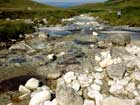 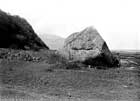 Streams
emanating from glens in the area of the Northern Granite are chock full
of granite boulders. Many granite boulders, some estimated to be around
400 tons in wieght, are found around the coast of Arran. They are though
to be erratics, and to have been moved by ice (see image on right). Streams
emanating from glens in the area of the Northern Granite are chock full
of granite boulders. Many granite boulders, some estimated to be around
400 tons in wieght, are found around the coast of Arran. They are though
to be erratics, and to have been moved by ice (see image on right).
|

